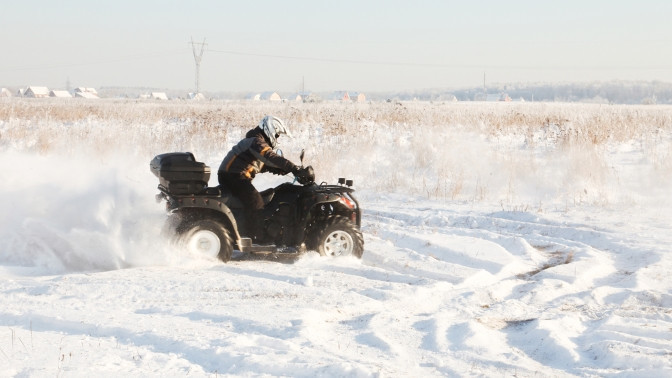Written by Brent Huntley in ATV Maintenence
An ATV that won’t start after sitting all winter can be a real pain. You might get it to turn over, only to have it die seconds later. Before you throw in the towel, there may still be hope for your ATV to start again. Using a checklist of common problems related to your ATV sitting all winter should help you to fix your ATV and get it running again.
How to start an ATV after it has been sitting for winter? Starting an ATV after it has been sitting all winter may require some standard tune-up maintenance including:
If you think that your ATV is not severely damaged and may have been sitting too long, this article will give you the details about cleaning, replacing, and fixing the critical components needed to get your ATV running again. Read on to find out the most common fixes for an ATV that won’t start after sitting for winter.
ATV’s and UTV’s usually sit idle and unused during the winter months. Proper storage of an ATV can help to keep all of the engine components clean and working. However, if the ATV has been sitting for a long time in poor conditions, improper storage, or just for an extended time during a long winter, several things could cause it not to start or run correctly.
Let’s check out the three most common fixes for an ATV that has been sitting for winter in more detail.
Flushing and Replacing Engine Fluids in your ATVWithin the engine of your ATV, several critical fluid types may have fouled if there is improper storage in poor weather conditions. Fouled fluids in the engine are especially common if the ATV was sitting somewhere below freezing or in excessive heat (not a winter problem, but good to know). Essential fluids to flush or replace are:
Essential fluids to flush or replace are:
The best way to check if the fuel in your ATV tank has gone bad is by the smell and color. Bad gas has a sour scent and darker color. Even the consistency will look and feel gummy, which means the gas has begun to deteriorate and is less combustible. This usually only happens after about six months of gas sitting without being used, but it can happen sooner than that.
The steps that need to be taken to flush and replace fuel tank fluids are:

Changing out old engine oil is an essential maintenance procedure that should be done on your ATV yearly. This is especially true if the ATV was run for long periods and many miles the year before and stored in extremely cold or hot temperatures.
The steps that need to be taken to drain and replace the engine oil on your ATV are:
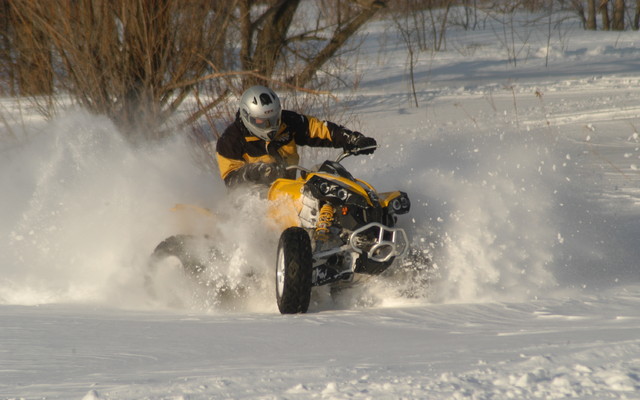 You may have to remove the ATV’s seat and use the pull tabs to gain access to the drain plug. Using a socket wrench, loosen the bolt and let the oil drain for fifteen minutes or so into a bucket.
You may have to remove the ATV’s seat and use the pull tabs to gain access to the drain plug. Using a socket wrench, loosen the bolt and let the oil drain for fifteen minutes or so into a bucket.  The kit comes with enough lubricant for several oil changes, a new filter, and o-rings, as well as directions.
The kit comes with enough lubricant for several oil changes, a new filter, and o-rings, as well as directions.If you have an older ATV with an old battery, you may either charge the battery back up to powerful enough to start the engine or completely replace the battery. Batteries tend to lose power as they sit in the cold, so if your ATV was stored all winter in the cold, you might need to charge it back up or replace it.
How to Charge your ATV BatteryIf you don’t feel you need to change the battery completely, you can use a battery charger or follow these easy instructions to charge your battery:

If you try to recharge it and can’t get it to take or keep the charge, follow these easy instructions to replace your ATV battery:
 The battery is connected to the motor with cables, and these cables can be loosened from the body of the ATV with a socket wrench. The battery clamp can be relaxed and removed with a screwdriver.
The battery is connected to the motor with cables, and these cables can be loosened from the body of the ATV with a socket wrench. The battery clamp can be relaxed and removed with a screwdriver.If you have questions about what battery to put in your ATV, head over to this article to figure it out.
How to Clean the Air Filter in your ATVAnother common problem that an ATV which has been sitting may experience is not getting enough air into the fuel mixture. If the fuel is not getting oxygen, the engine’s combustion will be inconsistent and could cause the engine to stall or not start. The most obvious culprit for oxygen/fuel mix problems is a bad or clogged air filter.
If the fuel is not getting oxygen, the engine’s combustion will be inconsistent and could cause the engine to stall or not start. The most obvious culprit for oxygen/fuel mix problems is a bad or clogged air filter.
Unlike car air filters, ATV air filters are made to be cleaned several times until dirt and debris build-up. Follow these easy instructions to clean the air filter on your ATV:
 Once dry, use air filter oil and spray it into the filter. Allow the oil to dry.
Once dry, use air filter oil and spray it into the filter. Allow the oil to dry. ATV’s have many components and systems that may need to be cleaned or replaced if they have been sitting in extreme weather conditions or are stored all winter long. By following one or all of these guidelines in this list, you can adequately care for your ATV and get it running again for the spring and summer months.
How To Use An ATV Spreader
One of the greatest things about summer is yard work. As the heat and humidity rise, so do the plants and flowers. The advent of technology has made seeding and fertilizing, a job that used to...
Continue Reading
link to When Should You Use High vs. Low Gear On Your ATV?
Low Gear On Your ATV?
When Should You Use High vs. Low Gear On Your ATV?
ATVs will provide any off-roader with a fun, thrilling experience. However, if you want to make the most of your ATVing trip without incident or frustration, it is important to know when and where to...
Continue Reading
Traditionally, the summer months are the months known for getting outdoors and hitting the trails on your ATV or UTV. But some of us like to ride all year round, even during the winter. There are a few things you can do to keep your ATV running nicely in the winter months.
If this is not you, and you would rather store your ATV for the winter, check out this Winterize Your ATV article here.
If you plan on riding during the winter months, it’s definitely a good idea to bundle up, as well as wear protective gear. But there’s also things you should do to your ATV, to keep it running smoothly, and to keep you from getting stuck or stranded in the cold temperatures.
Prepare your ATV for winter riding conditions ahead of time. Having your quad break down is no fun as it is, now add freezing temperatures to the mix, and you’ll be wishing you took more time to prepare your machine. Doing all the routine maintenance is a good idea, but here are some things you want to make sure you look at.
The main thing for your fuel is to make sure you don’t get moisture in the tank or fuel lines. This can happen especially in the cold because as the temperature drops water can condensate inside the tank. If you get water or moisture in your gas, it will prevent the engine from starting. The water can freeze in your fuel lines and prevent gas from getting to the engine, causing the ATV to run rough or not even start at all.
To prevent this from happening, add fuel stabilizer to your gas. Fuel stabilizer will keep your gas fresh and your engine running smoothly. The fuel stabilizer I use is this Sta-Bil Performance Fuel Treatment (link to Amazon). This stuff works great, I also use it in my lawn mower and motorcycle during winter storage. You simply add a little bit to your gas, and run the engine for a few minutes to allow the fuel stabilizer to get through all the fuel lines. The bottle comes with directions on how much to add per gallon of gas, so you can make sure you aren’t adding too much or too little.
This stuff works great, I also use it in my lawn mower and motorcycle during winter storage. You simply add a little bit to your gas, and run the engine for a few minutes to allow the fuel stabilizer to get through all the fuel lines. The bottle comes with directions on how much to add per gallon of gas, so you can make sure you aren’t adding too much or too little.
Another helpful tip is to keep your gas tank topped off as much as you can. That will help prevent water condensation on the inside of the tank.
Your battery really shouldn’t stay on the machine in cold weather without a smart charger or trickle charger of some kind. If you don’t want to buy a smart charger, you can take your battery off the quad and bring it inside to keep warm. The cold temperatures ruin batteries pretty quickly, and batteries can get expensive.
I don’t like having to take my battery out all the time to keep it charged up, so I bought a Ctek Smart Charger found here on Amazon, and a Ctek Comfort Connector. That way I can leave the battery right where it is. I just hook the smart charger to the comfort connector, and I’m good to go.
That way I can leave the battery right where it is. I just hook the smart charger to the comfort connector, and I’m good to go.
The great thing about this charger is that it stops charging when the battery’s full to prevent damaging the battery. A lot of trickle chargers don’t do that and it could cost you if you don’t set a timer or keep checking on the battery while it charges. With the setup I have, I just plug it in after a ride, and unplug it before I take the ATV out again, simple.
Spark plugs don’t need to be tended to every winter. But if you planned on changing them out that year anyway, doing it right before winter will give you the extra edge when starting your ATV in cold weather.
Usually I could go a couple to a few years before I need to replace the spark plugs, so I don’t do this every winter. Unless it’s a two stroke engine, then I’m replacing spark plugs all the time anyways. Make sure they are gapped right, and a new set of spark plugs will help keep your engine running through the winter.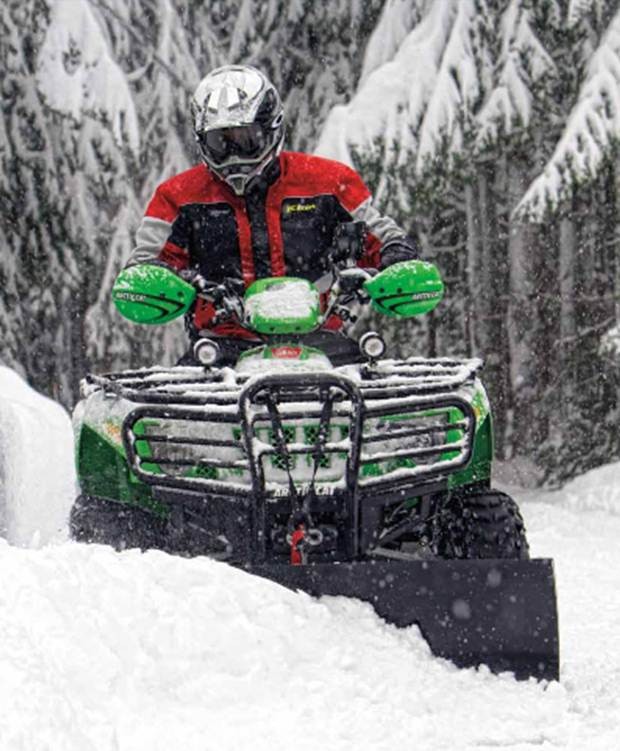
Keep an eye on the engine oil. The oil is what keeps your ATV running smoothly, and if your oil deteriorates you will notice rough starts and less power. If you’re doing regular oil changes, then there isn’t much you need to worry about here. Just make sure the oil is topped off, and you’ve been changing the oil and filter regularly. If it’s been a while since your last oil change, now might be a good time for it.
There isn’t much to do with your tires for winter riding, unless you want to get tire chains or something like that. They even make studded tires that were designed to be ridden on ice and snow. But if you’re not planning on riding across frozen lakes, you probably don’t need studded tires.
One thing you can do is let a little air out of your tires to help with traction. I would suggest starting with 4 psi in your tires and adjust from there based on how you want the ride to feel. Having your ATV tires slightly under-inflated helps in a couple ways. One is that you increase the surface area of the tire as it contacts the ground, giving you better traction in the snow. Another way it helps is that it increases the flat spot on the bottom of the tire where it rests on the ground, allowing you to stay on top of the snow more easily.
One is that you increase the surface area of the tire as it contacts the ground, giving you better traction in the snow. Another way it helps is that it increases the flat spot on the bottom of the tire where it rests on the ground, allowing you to stay on top of the snow more easily.
Clean out your air filter or replace it entirely if it needs it. After months of warm weather riding, your air filter will be filled with dust and debris. As snow starts to fly around you on the trail, it will no doubt be pulled into the air filter. As it collects with the dust, it will start to form a mud or paste like substance in your filter. Your engine won’t be getting the proper air flow it needs to stay running at it’s best.
Usually a quick blow out of the filter will work. If it’s been a while since you’ve changed the filter out completely, now might be a good time for that.
Now for some fun add-ons you can get for your ATV to make winter riding more comfortable and enjoyable.
Hand guards will work wonders at keeping your hands warm in cold weather. Even if you’re wearing thick winter gloves, the wind can still work its way to your hands over time. Another benefit of hand guards is that they keep branches, rocks, and other things from hitting your hands. You might like them enough to keep them on all year round.
If you do want to add hand guards to your ATV, I suggest looking at these PowerMadd Sentinel Hand guards (link to Amazon). They get excellent reviews, and people seem to love them. Be careful though, you do need to buy the mounting hardware separately. They do this because the mounting hardware is different for different quads. Make sure you get the one that fits your machine specifically.
Heated hand grips are really a luxury item if you ask me. With these and some hand guards, you could ride for hours without your hands getting cold. They usually cost between 50 – 100 dollars, but if comfort’s what you’re after, these will do the trick.
I recommend this set, the Heat Demon Heated Grip Kit from Amazon. They cost around $55, and get great reviews. There is no adhesive required to install, they just slip on and off any 7/8″ ATV handle bars, which is what size most ATV handle bars are. Everything you need to get yourself some heated hand grips comes in the kit.
Your ATV is going to handle differently in the snow. Everything from accelerating, steering, turning, and stopping will be off. If you get a good pair of mudding or snow tires, the effects may be lessened, but you still won’t have the levels of control you’re used to. If your trail crosses some small streams or ponds, or even something bigger like a frozen over lake, you might want to look into getting some tire chains.
If you just want a cheap pair of tire chains to throw onto your ATV tires, then I suggest these Titan ATV Tire Chains (link to Amazon). They’ll run you about $46, and get great reviews. This is the set I bought when I wanted to do some winter trail riding on my quad. I had them on the rear tires only, and they worked amazing. They help you keep traction if you’re doing something like plowing the driveway too.
This is the set I bought when I wanted to do some winter trail riding on my quad. I had them on the rear tires only, and they worked amazing. They help you keep traction if you’re doing something like plowing the driveway too.
They come in different sizes, so make sure you get the right size for your tire. If you have these on, you don’t need to worry about lowering your tire pressure either. You’ll get better traction with these on than messing with tire pressure at all. I did deflate my tires a bit to make putting the chains on easier. Then I just refilled my tires to 5-6 psi and I was good to go.
The Titan ATV Tire Chains are the best set of tire chains for the money that I have found yet. But if you’re ok with spending a little extra cash to get the best equipment for your machine, then check out these Grizzlar Diamond Studded Tire Chains from Amazon. These are the best of the best tire chains out there. They’re designed in a way to maximize chain to ground coverage. Meaning that they have better traction and coverage than the standard ladder style tire chains. They’re a bit pricey for my liking, but if you want the best, there it is.
Meaning that they have better traction and coverage than the standard ladder style tire chains. They’re a bit pricey for my liking, but if you want the best, there it is.

As always, wear protective gear. There are branches and other obstacle that get hidden under a layer of snow. As soon as your tire hits them though, they can come flying up and hit you. If you want to see some gear I have tried and tested out, check out the Recommended Gear section of this site.
Sharing is caring!
Contents:
ATV trips are a pleasure not only in the warm season, but also in winter. In addition, in winter there is always work for the ATV, for example, to remove snow from the driveway. However, the operation of an ATV in winter has a number of features that must be considered in order to avoid problems and breakdowns.
However, the operation of an ATV in winter has a number of features that must be considered in order to avoid problems and breakdowns.
Consider not only the process of driving an ATV, but also the preparation of an ATV for winter operation.
To operate the ATV in winter, change the engine oil to a lower viscosity grade. If 10W-40 is suitable in the warm season, then it would be advisable to use 5W-40 for winter. It is also worth considering that this should be a synthetic oil for ATVs or motorcycles, not for cars, as it contains special additives for wet clutch operation.
Recommended oil for CFMOTO ATVs is CFMOTO G-Motion , which is adapted to the peculiarities of the operation of equipment in Russia, has passed multiple tests and has an increased margin of protective properties, ensuring uninterrupted operation of the engine in all operating modes, including extreme ones.
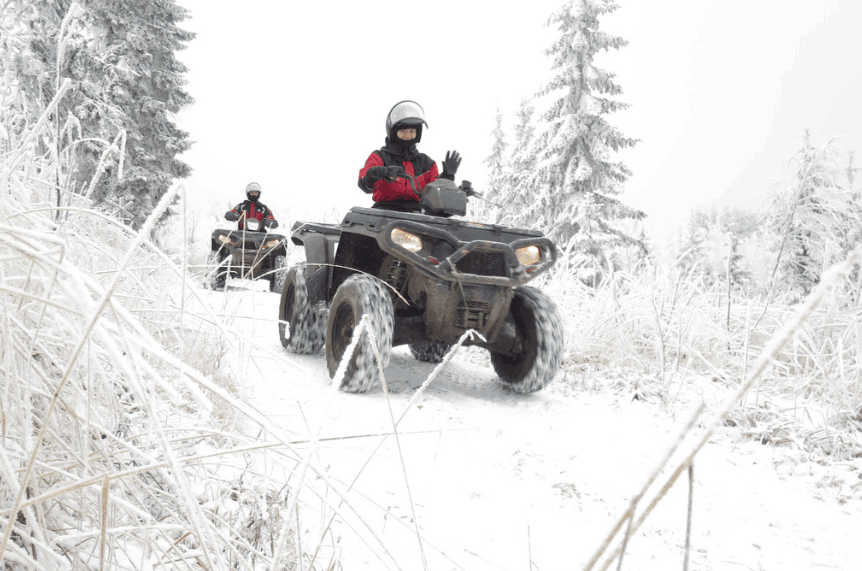 Fill in high-quality antifreeze
Fill in high-quality antifreeze It happens that after summer operation there is water in the cooling system, which can freeze at low temperatures. Before the onset of cold weather, we recommend pouring only high-quality antifreeze or antifreeze into the ATV cooling system.
Tested and recommended for CFMOTO ATVs is CFMOTO G-Motion Antifreeze .
It is recommended to remove the additional protection from the levers during the winter, as it can trap and accumulate snow. In view of the proximity to the heating elements of the transmission, this snow will subsequently turn into ice growths that can damage the anthers of the CV joints.
You should also think about removing the underbody protection for the winter, because if you decide to overcome a water barrier on an ATV in winter, then there is a risk of carrying frozen snow and ice with you until spring. However, without bottom protection, you should be more careful in choosing routes.
However, without bottom protection, you should be more careful in choosing routes.
In winter, the battery can be a hassle. The normal battery charge is 12.5V and this indicator must be monitored and the battery recharged in a timely manner.
If your ATV is stored outdoors, the best solution is to remove and bring the battery into a house or other warm area.
Always warm up the engine before winter driving. On average, 5 minutes will be enough. This is necessary so that the oil is evenly distributed throughout the engine.
No matter how warm your gloves are, installing heated grips and heated triggers will help keep you comfortable when riding an ATV in the winter. Heatings have two heating modes (strong and weak), providing a comfortable ride on an ATV both in the autumn-spring period and in cold winter.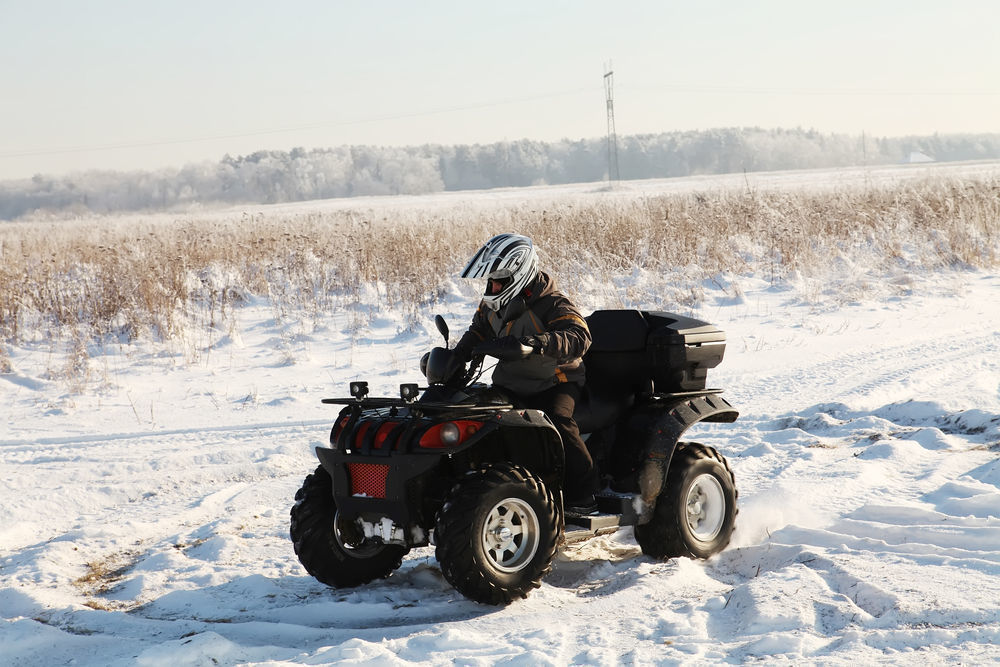
If your ATV has fuel injection, then there will be no problems in winter. Owners of carburetor models will have to attend to actions to enrich the fuel mixture and remember the principles of working with a starting enricher (called an air damper in the manuals). It is necessary to start a cold engine with the enricher open, when it is already started - you should move the lever to the middle position to warm up the engine. As soon as the engine warms up, the lever can be returned to the working position and the ride can begin.
Any winter ATV trip can be overshadowed by out-of-season gear. Be sure to wear special winter equipment , because even if your ATV is completely ready for winter rides, you should be ready for them too: use thermal underwear, a heated helmet, special winter jackets, pants, gloves and boots.
Otherwise ATV winter operation is not much different from other seasons.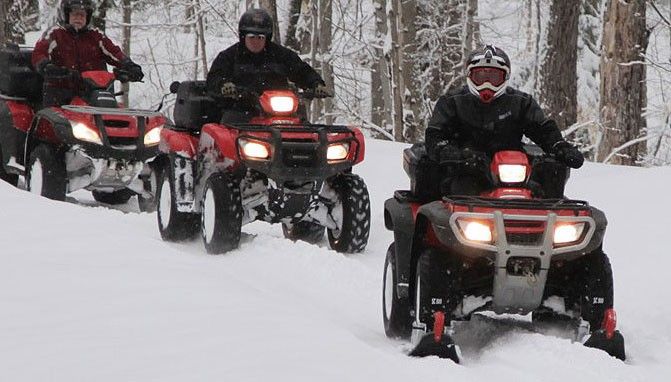
Therefore, you should not think about whether it is possible to ride an ATV in winter. Of course it is possible and even necessary! It is winter operation that will allow you to gain new experience, open up new management opportunities and test your equipment in new and sometimes more interesting conditions.
Winter is coming. But who said you can't ride an ATV in cold weather? In fact, frost will only be a hindrance if proper precautions are not taken before setting out on a day's journey.
ATV owners usually don't store them in their living quarters where they can stay warm. Even a domestic cat moves from the garage to the house on cold nights, but what about an ATV? Cars usually stay outside, but that doesn't mean they can easily endure the cold. But the temperature in a garage or under a shed very often drops below zero, especially when the mercury column in the thermometer shows -12 degrees outside.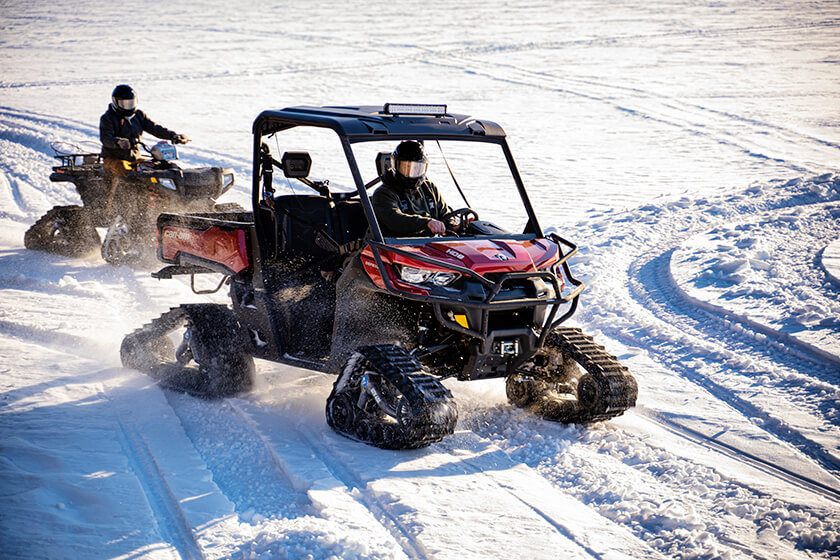
Sometimes severe frosts come before the first snow. Therefore, it is possible that during the first winter trips on an ATV, the roads will be clean. However, do not think that starting the engine in such weather will be as easy as on a 26-degree summer day. ATVs don't like cold weather more than their riders. They require proper warm-up before opening the throttle. So if you're itching to get outside and your ATV is in the garage, we recommend that you complete the following checks and take action before heading out into the searing cold of the outdoors.
Like a car, ATVs are also difficult to start in the cold. Fluids get thicker, spark plugs don't spark, and manufacturers don't make motor oils with -5w-30 specifications. Don't be surprised if you get a "hard start" where the engine starts with some effort and its running sound is unusually harsh until the oil has lubricated all the components.
Engine overheating is usually a major concern for drivers, especially those who race and forget to add antifreeze to their coolant.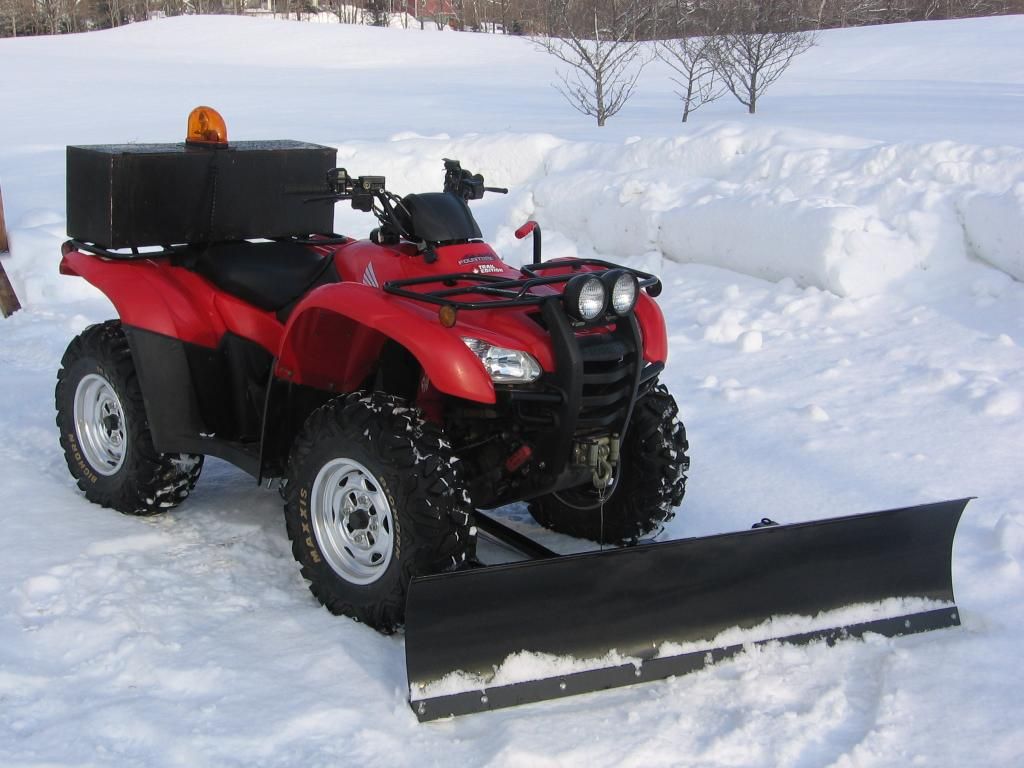 But for those who ride all-terrain vehicles in nature, to remove snow or hunt in cold weather, antifreeze is necessary. Chances are they already use the recommended antifreeze for their cars.
But for those who ride all-terrain vehicles in nature, to remove snow or hunt in cold weather, antifreeze is necessary. Chances are they already use the recommended antifreeze for their cars.
After starting, there will be no problems with engine operation in cold weather. However, if the coolant is of poor quality, contains too much water, or is not certified for low temperatures, it may freeze if the ATV is stored in freezing temperatures. Even more problematic is the expansion of the freezing liquid, which can cause serious damage to individual engine components made of non-ductile cast aluminum and steel. Cylinder walls and water jackets containing engine cooling fluid may be damaged.
Before starting the ATV, check the coolant to make sure it is not frozen. If this happens, you should not start the engine. You need to melt it and replace it. Frozen fluid will be spoiled, and if you continue to use it, the engine will overheat. To avoid freezing of the coolant, it is recommended to replace it immediately after the summer season by adding antifreeze, which protects against freezing and overheating.
Note: Most known refrigerants will not freeze, at least at temperatures slightly above freezing. But for harsher, more extreme weather conditions, a refrigerant with antifreeze is required.
Even if the vehicle is not used in winter, it is best to replace the old coolant with new antifreeze fluid to avoid any problems during winter storage of the vehicle.
Don't be surprised if the suspension feels a bit stiff at the beginning of the ride. You don't have to worry - this is normal. Keep moving on. The suspension will not work properly until the thick fluid is heated. It will return to normal after approximately 10 minutes of driving.
Although this is rare, it is still possible. The engine may stall in cold weather if the throttle is turned off too soon after starting. This is called a cold engine failure. Ice-cold oil cannot provide the required lubrication immediately. Therefore, even after the engine has started, it is necessary to let it run at low speed for a while until the oil warms up before increasing the speed.